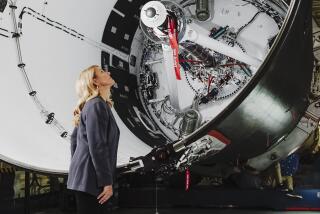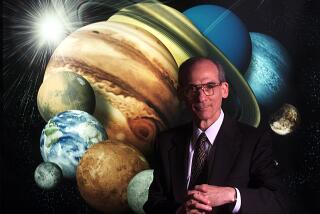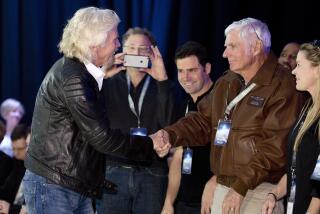Edward N. Hall, 91; Rocket Pioneer Seen as the Father of Minuteman ICBM
Col. Edward N. Hall, the U.S. Air Forceâs foremost rocket expert who is widely considered the father of the Minuteman intercontinental ballistic missile program that is the core of this countryâs missile defense, died Sunday at Torrance Memorial Medical Center.
He was 91 and had been bedridden at his home in Rolling Hills Estates for 1 1/2 years with a broken hip and other ailments.
For the record:
12:00 a.m. Feb. 16, 2006 For The Record
Los Angeles Times Thursday February 16, 2006 Home Edition Main News Part A Page 2 National Desk 2 inches; 78 words Type of Material: Correction
Edward Hall obituary -- An obituary of Edward N. Hall in the Jan. 18 California section stated that âthe solid-fuel rocket technology that he helped develop was subsequently used in most other U.S. missiles, including the Polaris, the Titan III and IV and the boosters on the space shuttle.â The Titan IV and some versions of the Titan III used solid boosters in addition to liquid-propellant engines, and other versions of the Titan III used only liquid propellants.
The solid-fuel rocket technology that he helped develop was subsequently used in most other U.S. missiles, including the Polaris, the Titan III and IV and the boosters on the space shuttle.
Early U.S. rockets were liquid fueled, typically operating on a mixture of liquid oxygen and alcohol or kerosene. But these compounds were sufficiently unstable that the rockets could not be kept fueled and ready for launch.
Instead, the fuels had to be pumped in before launch through a complicated system of pipes, a slow and sometimes dangerous process that required a high level of skill.
A solid-fuel rocket, in contrast, could be kept safely fueled and ready for launch at a momentâs notice. But early solid fuels did not generate enough power to lift a rocket into space, they had a disturbing tendency to burn through the sides of the rocket casing, and they could not be shut down once ignited.
Working with engineers at companies such as Thiokol and Boeing, Hall was able to overcome these problems.
To increase thrust, the team began using a mixture of ammonium perchlorate, which provided oxygen for the rocketâs internal fire, and aluminum, which served as a fuel. The two were mixed and encased in a rubber-like polymer that also burned upon ignition.
To provide even thrust without damaging the rocket, the team built upon a technique developed in a small British laboratory. Instead of having the fuel burn at one end, as early rockets had, they cast a star-shaped opening all the way through the solid fuel, allowing the propellant to burn from the inside out.
In this fashion, the propellant had a constant surface size, which provided even power output throughout the burn, and the remaining propellant also served to insulate the sides of the craft from the intense heat generated by the motor.
They even developed a way to shut the rocket down, a feat that many engineers had not believed possible, but one that was necessary for an ICBM to be able to hit its target accurately. To achieve this, they installed precision shutdown ports on the rocket chamber that, when opened in flight, reduced the chamber pressure so abruptly that the propellant was snuffed out.
The first 10 Minuteman ICBMs using this technology were installed in underground launching silos in October 1962, during the Cuban missile crisis.
Eventually, more than 1,000 were installed in silos throughout the country, but disarmament agreements have scaled the number back to 500.
Each of the third-generation Minutemen now in place, however, carries three independently targeted warheads, in effect making them three ICBMs in one.
Although Hall was not directly involved, the same technology was used in the U.S. Navyâs Polaris missile, which could be launched from a submarine, and the Titan III and IV rockets, which served not only as ICBMs, but also as launch vehicles for the Gemini astronauts.
Edward Nathaniel Hall was born in New York City on Aug. 4, 1914, as World War I broke out. He was the son of a furrier who went broke in the Depression, but he was able to gain admission to the elite Townsend Harris Hall school through a competitive examination.
Hall studied chemical engineering at City College of New York, but couldnât find a job after graduation because of the economy, so he enlisted in the U.S. Army Air Forces. After the Japanese attack on Pearl Harbor, he was commissioned a second lieutenant and sent to Britain, where he supervised the repair and maintenance of B-17 bombers.
In 1943, he received the Legion of Merit for devising a rapid method for repairing serious fuselage damage caused by anti-aircraft fire and enemy fighters.
He developed an interest in rocketry when he was sent to the captured V-2 factory near Nordhausen in north central Germany when the Nazis surrendered in May 1945. There he oversaw the division of spoils between the U.S. and England.
He was subsequently assigned to Wright-Patterson Air Force Base in Dayton, Ohio, where he was soon building bigger and better liquid-fueled engines. By 1954, he had constructed one with a thrust of 135,000 pounds, more than double the 56,000 pounds of thrust produced by the German V-2.
His work was crucial in the development of the Bomarc, Navajo, Snark, Rascal and Falcon missiles, as well as the Atlas and Titan I ICBMs.
But he ultimately recognized the futility of trying to build bigger and better liquid-fueled engines and switched to work on solid fuels in 1957. That work led to a second Legion of Merit in 1960.
After he left the Air Force in 1959, he spent 14 years as an engineer at United Aircraft Corp. before retiring and beginning a number of consultations with other companies.
In 1999, he was given the Air Force Space and Missile Pioneers Award and made a member of the Hall of Fame at the U.S. Air Force Space Command at Peterson Air Force Base in Colorado.
He is survived by his wife of 62 years, Edith Shawcross Hall; a daughter, Sheila Hall, of Calabasas; and two sons, David of La Crescenta and Jonathan of Kendall Park, N.J.
More to Read
Sign up for Essential California
The most important California stories and recommendations in your inbox every morning.
You may occasionally receive promotional content from the Los Angeles Times.










